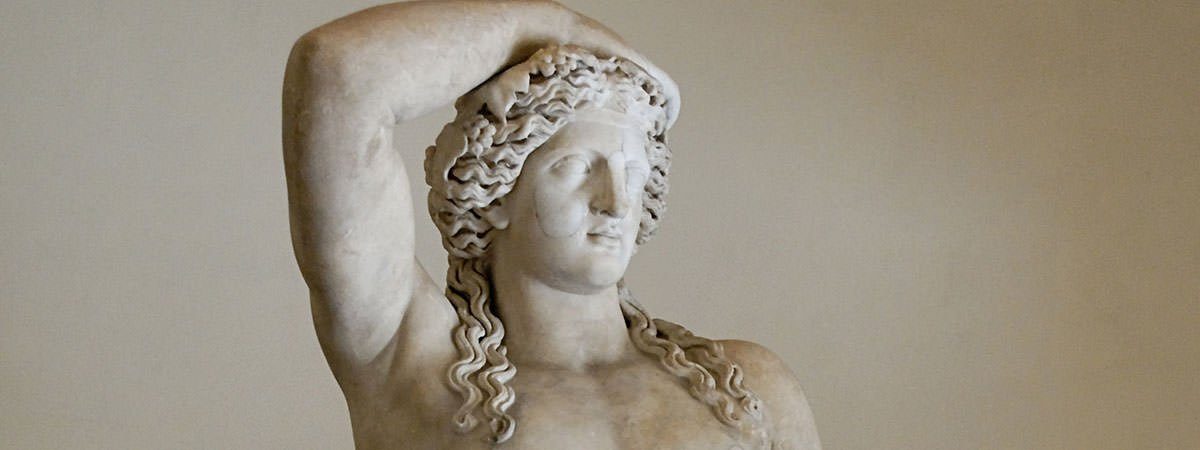In Greek mythology, Dionysus is the Olympian God of fertility, wine, wine-making, madness and festivity. He is the God of viticulture and grapes, connected to the growth and harvest of the fruit. With wine being an integral part of ancient Greek culture and festivity, Dionysus was among the more popular deities, and his cults were the main religious focus during the production and consumption of wine. According to the common tradition, Dionysus is the son of Zeus (King of the Olympian Gods) and the mortal Semele, daughter of the Phonetician hero Cadmus of Thebes. Orphic legends (based on the stories of Orpheus), however claim him to be the son of Zeus and Persephone (Queen of the Underworld). Known as Bacchus or Liber (free) among the Romans, Dionysus was also later associated with art forms and considered as the patron of artists. His festival held during the spring time was in fact the initial driving force behind the development of Greek and Roman theater. Dionysus’s attributes included the thyrsos (a pine-cone tipped staff), a drinking cup and a crown of ivy. He was frequently depicted with bull horns and riding a panther. In myth Dionysus is often referred to as a foreigner and is portrayed as an effeminate, long-haired youth. It is said that he wandered the world spreading his cult and was usually accompanied by a troop of satyrs (half-human, half-goat creatures) and maenads, wild female devotees flush with wine and draped with a fawn skin. The cult of Dionysus was also a “cult of the souls”; where his maenads fed the dead through blood-offerings, and Dionysus acted as a divine communicant between the living and the dead. Know more of the Greek God of wine through the 10 most famous myths featuring Dionysus.
#1 Twice Born
Semele was the princess of Thebes, daughter of the Phonetician hero Cadmus and the Goddess Harmonia. Once while performing a sacrifice of a bull on the altar of Zeus, Semele caught the fancy of the King of the Olympian Gods. Zeus thus pursued Semele and was soon involved in an affair with the princess. In time Semele became pregnant with Zeus’s child Dionysus, and Hera (Zeus’s wife) found out about her husband’s affair. A jealous and enraged Hera thus planned her revenge on Semele. Knowing that no mortal could see him in his true form, Zeus had been visiting Semele in a human form. Hera disguised herself and befriended Semele and when the princess confided in her about her affair with Zeus, Hera cast some doubts over the claim. The Goddess then convinced Semele to witness the divine form of Zeus. In suspicion and curiosity, Semele decided to ask Zeus for a wish, making him take an oath on the river Styx that he would grant her anything. Finally when Zeus submitted out of his love, Semele wished to see him in all his glory. A crestfallen Zeus had no option but to comply. The mortal Semele as a result was consumed by flames and turned to ash. Zeus however managed to save the unborn Dionysus from the flames and sewed the baby inside his thigh, where it gestated until it was time for birth. Dionysus was thus born twice and gained immortality from being born from Zeus’s thigh. In certain myths, Semele was later rescued by her son Dionysus from the underworld and ascended to Olympus to live with her son.
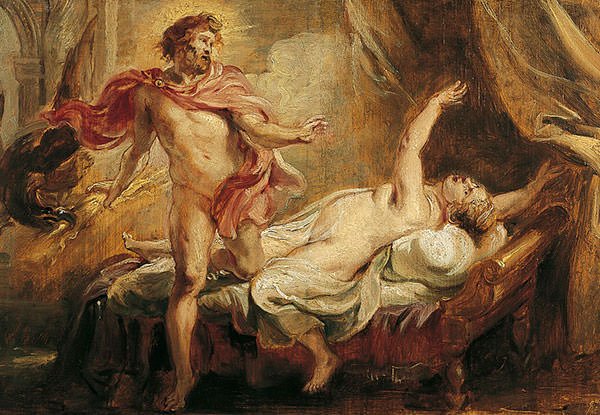
#2 Orphic legend of Zeus and Persephone
According to Orphic legends (based on the stories of Orpheus), Dionysus was the child of Zeus and Persephone (Queen of the Underworld and daughter of Zeus and Demeter). In what was not uncommon among the Greek Gods, Persephone was simultaneously Zeus’s daughter, niece and sister-in-law. According to myth, Zeus seduced Persephone in a cave in the form of a serpent and the union resulted in the birth of Dionysus. The child was a favorite of his father who despite his infancy was able to climb onto the throne of Zeus and brandish his lightning bolts, making him in many ways the successor of Zeus. This was not acceptable to Hera, who in her jealousy incited the Titans to kill the child. With her assistance, the Titans finally managed to accomplish the task and the infant Dionysus was torn apart and eaten. However, Athena (Goddess of wisdom and warfare) managed to save the child’s heart and gave it to Zeus. An enraged Zeus struck the Titans with lightning, and they were consumed by fire. He then put the surviving heart into a potion and gave it to one of his mortal lovers, Semele. Finally Dionysus was born from Semele as the reincarnation of the son Persephone had born.
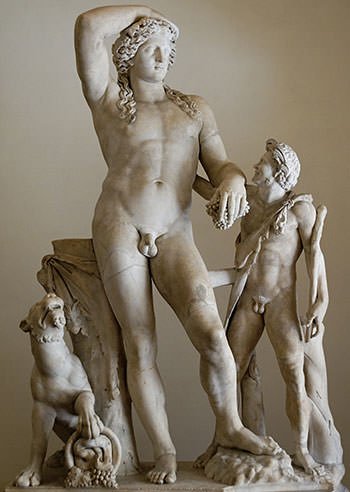
#3 Hermes and the infant Dionysus
Hermes was the fun loving trickster God and the herald of the Olympians. Dionysus was Zeus’s love child and the later was aware of Hera’s jealousy towards the infant. Zeus hence called upon his trusted messenger Hermes and handed over the responsibility of the infant Dionysus to him. According to one myth Hermes then handed over Dionysus to the river nymphs called Lamides, daughters of the river God Lamos. The Lamides nursed Dionysus but were driven to madness by Hera which led them to attack the child. Dionysus was however rescued by Hermes and taken to Ino, the mortal queen of Boeotia and Semele’s sister. Here Dionysus was fostered by the Mystis, the queen’s attendants who taught him the rites of the mysteries. The child was being raised as a girl to escape Hera’s eyes but the Goddess eventually found out and vowed to destroy the habitation with a flood. Hermes came to Dionysus’ rescue yet again and this time took the child to the mountains of Lydia. Dionysus was finally handed over to Rhea (Titan queen and mother of Hera), who took care of him through his adolescence. According to another story Hermes took the infant Dionysus to the rain-nymphs of Nysa, who nourished his infancy and childhood. In yet another version of the myth, he is raised by his cousin Macris on the island of Euboea.

#4 Pentheus of Thebes
According to Greek myth interpreted from Euripides’ tragic play “The Bacchae”, Pentheus became the King of Thebes following the abdication of the throne by his grandfather Cadmus (founder of Thebes). Upon gaining power, Pentheus banished the worship of Dionysus (son of his aunt Semele) in Thebes and forbade the women of his kingdom to attend the religious rites of the God. This angered Dionysus who cast a spell of Bacchic frenzy causing all the women of Thebes to rush to Mt. Cithareon and attend his ritual. Dionysus was hence captured and imprisoned by Pentheus, but not for long as the former was miraculously released from his chains and his prison cell. Dionysus now seeking revenge disguised himself as a woman and lured Pentheus to spy on the Bacchic rituals with all their sexual frenzy. Unable to resist the invitation, Pentheus hid behind a tree and climbed it for a better view. He was however seen in his act by the maenads, who in their madness mistook him as a wild animal. They pulled him off the tree and tore him apart limb from limb (in an act of Bacchic sparagmos). The first to attack Pentheus was his mother Agave, who would only realize what had happened after returning to her senses.
#5 Icarius and Dionysus
Icarius (not Icarus who failed in his flight) was an Athenian hero who was visited by Dionysus during his visit to Attica. Icarius welcomed the God and was instructed by Dionysus in the art of wine-making. Eager to share his new craft and the grace of the Gods with mankind, Icarius presented the wine to his shepherds. The men drank the portions in one go and, feeling that they have been poisoned, killed the innocent Icarius. Realizing their folly upon regaining their senses, the shepherds buried Icarius, where he was subsequently found by his daughter Erigone with the help of her dog Maera. Driven by grief Erigone hanged herself over her father’s grave. When Dionysus realized what had transpired, he punished Athens with drought and plague, inflicting insanity on all the unmarried women, who hung themselves like Erigone did. The desperate Athenians approached Apollo and Dionysus finally agreed to lift his curse when the Athenians decided to honor the deaths of Icarius and Erigone each year.

#6 Dionysus And Midas
Silenus was Dionysus’s teacher who was more like a foster father to the later. Once Silenus went missing and wandered off in a drunk state into Phrygia, the kingdom of Midas. Here, he accidentally fell into a whirlpool and would have drowned had it not been for King Midas who pulled him out. Midas recognized Silenus and treated him with respect and kind, finally delivering him to Dionysus who had been growing anxious about his teacher. An elated Dionysus granted Midas with a wish, as a reward for his kind act. Midas in return wished that anything he touches may turn into gold. Dionysus consented and an overjoyed Midas was quick to test his newly gotten power. Rejoicing he returned home and ordered his servants to arrange for a feast, only to find that all his food and drink was now turned into gold. Finally when he hugged his daughter and she turned into gold, Midas realized the consequences of his mistake and greed. Desperate and repentant he prayed to Dionysus, begging to be delivered from his starvation. Finally Dionysus paid heed to his prayers and the curse was lifted after Midas washed his hands in the river Pactolus.
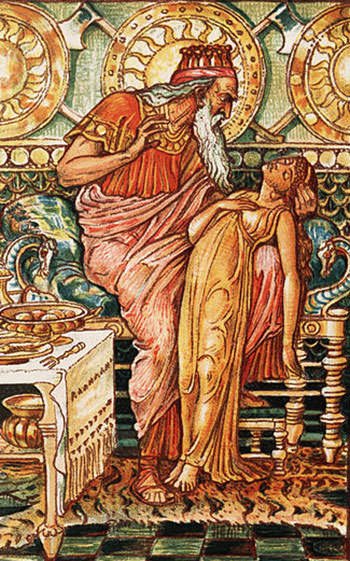
#7 Tyrrhenian Pirates
Dionysus was once captured by pirates from the Italian region of Tyrrenhia who had promised him a ride to Naxos. The pirates tied him to the deck and were planning to violate him and sell him off as a slave in Asia. An enraged Dionysus filled the ship with spreading vines and beasts. With lions and panthers attacking the ship, the frantic pirates jumped from the ship and were transformed into dolphins once they landed in the waters. One among them was put in the sky as the constellation Delphinus, a warning for sailors to behave.
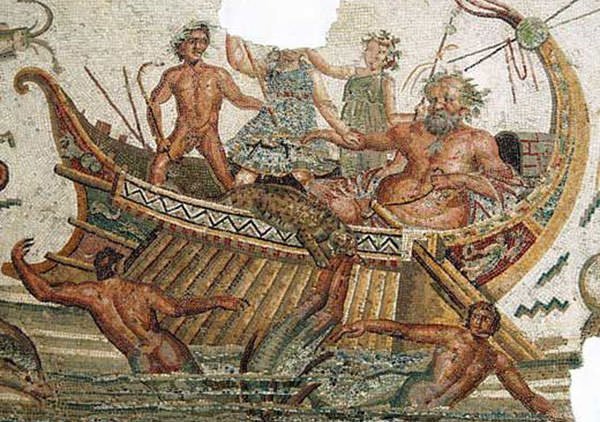
#8 Dionysus And Lycurgus
Lycurgus was the King of the Edones in Thrace, who according to a Homeric myth, once attacked Dionysus and his worshipers on the sacred mountain of Nysa. As Dionysus fled from the scene by jumping into the sea, he was received and protected by the sea nymph Thetis (Nereid). An angry Zeus thus attacked the murderous Lycurgus blinding him and the king did not survive long after that. In another variation of the myth when Lycurgus drove away Dionysus from his kingdom and imprisoned the maenads, the God cursed his land with drought and him with madness. Having gone insane Lycurgus mistook his son for a mature trunk of ivy (holy to Dionysus) and killed him with an axe. After regaining his senses Lycurgus found his lands barren and the Oracle proclaimed that fertility to the land would only be restored if Lycurgus was killed. The king was thus tied by his own people and fed to the flesh eating horses on Mount Pangaeum.
#9 Dionysus And Ariadne
Ariadne was the princess of Crete and the daughter of Minos, the King who in return for not attacking Athens had demanded the sacrifice of 7 Athenian boys and girls each. The sacrifice was to be sent every 9 years to the labyrinth of Knossos, where the boys and girls were eventually consumed by the Minotaur (creature that was half man and half bull). Ariadne was put in charge of the labyrinth, but she betrayed her father when she fell in love with the Athenian hero Theseus and gave him a golden thread to get through the Minotaur maze. Ariadne thus assisted Theseus in killing the Minotaur and fled with the hero aboard his ship. Though Theseus had promised marriage with her, he soon abandoned Ariadne on the island of Naxos while she was sleeping. She was discovered here by Dionysus who brought her to Olympus where the couple were married.
In some variations of the myth it was Dionysus himself that had instructed Theseus in a dream for his crude action, for the God already had his eyes on Ariadne. Other variations point to Dionysus and Ariadne being married long before, when Dionysus was spreading his cult around the world. Ariadne was later slain or turned to stone by King Perseus while he fought against a band of sea women and the Argives. Dionysus then descended into the underworld to recover her and brought her back with him to Olympus. Ariadne went on to have several children with Dionysus with the most noted being Oenopion (king of Chios), Staphylus and Thoas (king of Lemnos).

#10 Orpheus and Dionysus
In Greek Mythology, Orpheus was a legendary poet, singer, musician and seer, who was the founder and prophet of the so-called “Orphic” mysteries. Orpheus was so gifted in his art that he had the ability to charm all living things and even stones with his music. According to a summary of Aeschylus’ lost play Bassarids, as Orpheus grew older he became a devout worshiper of Apollo (God of wisdom), while looking at all the other Gods with disdain. Once while he was visiting the oracle of Dionysus at Mount Pangaion, and giving his salutations to the God of dawn Apollo, Orpheus invited the wrath of Dionysus. He was thus ripped apart into shreds by Thracian Maenads for not honoring his previous patron Dionysus. Other legends claim that Orpheus became a follower of Dionysus and spread his cult across the land. In this version of the legend, it is said that Orpheus was torn to shreds by the women of Thrace for his inattention.

